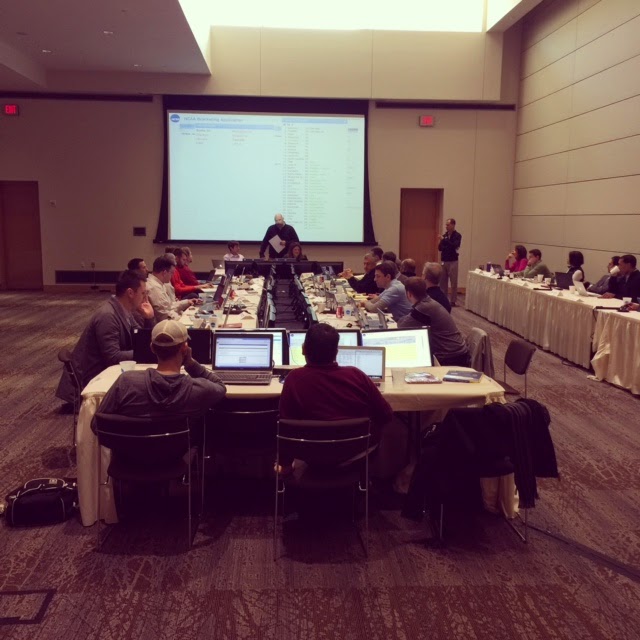It’s that time of year, March to be exact, when
college basketball fans, league administrators, coaches and even players start
to think about the NCAA Tournament and where their team fits in, if at all.
For the NCAA Tournament Selection Committee, and bracketologists
like me, the thought process begins much earlier.
A few weeks ago, I had the pleasure of taking part in the NCAA Mock
Selection Exercise, where David Worlock, Director of Media Coordination and
Statistics for the NCAA, invites college basketball media members to
participate in a condensed (two full days, rather than five) mock selection of
the 68 teams that will make up the upcoming NCAA Tournament.
We were entrusted with selecting the field in the same manner the
actual Selection Committee does.
We were provided the same team, schedule, and ranking information; holed
up in an Indianapolis conference room, all sitting together at one giant
conference table with laptops and scattered notes abounding; and were expertly guided
by Mr. Worlock and JoAn Scott, veterans of the process who will be acting in
the same capacity in two weeks.
Though I felt I had a solid understanding of the process going in, I
learned a great deal more.
Of course, there is much speculation about how teams are selected
for the tournament and the factors that are rightly or wrongly considered,
including the dreaded conspiracy theories. But, to set the record straight,
let’s talk about what really goes down…
Initial preparation
As mock committee members, we were asked to come prepared with a
list of the teams we believed to be at-large locks, as well as a list of those
we believed deserved consideration or debate.
Teams that receive all but two of the eligible votes (an Athletic
Director/committee member may not vote for his/her own team) automatically make
the tournament field with no further debate.
As for the rest of the non automatic bid field, any team that
receives at least three votes in the lock and/or consideration categories is
placed on the “Under Consideration Board” for debate.
From the Board to the Dance
Now comes the fun part.
 |
| Inside the Mock Selection Exercise. |
The committee must now vote on the top eight teams left on the
board.
There is discussion and debate. Schedules are discussed, numbers are
thrown about, and the committee members’ opinions on various teams are
expressed and challenged.
After eight teams emerge as the top vote-getters, we are asked to
vote for our top four out of that group. The four winners of that vote are now
in the field. The other four are thrown back onto the Under Consideration Board
to survive yet another vote.
This process is repeated until the at-large field is set.
Scrubbing
After the field is set based on the above voting, committee members
take a closer look at their proper seeding by “scrubbing” the board.
The teams are on the board numbered from 1-68, based on when they
were voted into the field. In order to fine-tune the seeding, each team is
meticulously compared to the team above or below it in order to determine
whether they should be moved up or down.
Keep in mind that games are being played during the selection
process, so teams are constantly moving on the board, based on conference
tournament results.
What matters?
What matters most to the committee members when deciding what teams
should make the field, you ask? Well, everything.
Of course, this is a human process, so whatever is important to an
individual committee member can play a role in that committee member’s
thinking.
It has been stated that the RPI is the only metric that the
committee uses. This is technically true since teams are grouped and team
sheets are largely based on RPI rankings – top 50 wins, for example, refer to
RPI top 50.
However, the committee requests and has immediate access to all of
the other popular metrics, including, but not limited to Sagarin, Ken Pomeroy
and BPI. So, these “other” rankings can and often are discussed when debating
teams.
So, yes, the RPI is inherent in the selection process, but it is far
from the sole determinant.
Moreover, the dreaded eye-test plays a role, as members will discuss
the times they witnessed a particular team in person and how such team
performed. Although, I would argue that the eye-test is inherent in any debate
on college basketball that includes people who watch college basketball, at
least subconsciously.
Bracketing
The final order of the day (or days) for the committee is to decide
who plays who and where and when.
Only top 4 seeds are “protected.”
That means the committee will only go out of their way to protect,
either geographically or competitively, the top 16 teams in the tournament.
Geography is, without question, regarded as the biggest form of
protection.
So, those who wonder if a 2 seed in this year’s tournament is more
likely to be placed in a region close to campus or shipped far away from the
Kentucky Wildcats, the answer is they will likely be playing somewhere their
friends, family and fans have an easier time getting to.
In fact, in the bracketing process, when a team pops up on the board
to be placed, the distance in miles from campus to each playing site is
displayed prominently.
And there you have it
Despite all the conspiracy theories that float like the bubbles the
tournament has made famous, the selection committees consistently do a reputable
job.
How else could a good bracketologist consistently come within one or
two teams of predicting the field (although, this year threatens to be a bit
more unpredictable)?
Almost always, the right teams get in. And always, the NCAA
Tournament turns out to be the best sporting event of the year.
This first appeared on College Hoops Daily, The College Basketball Blog.
No comments:
Post a Comment